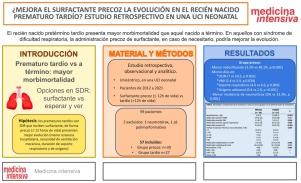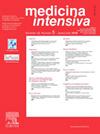早期表面活性剂能改善早产儿的发育吗?新生儿重症监护病房的回顾性研究
IF 3.1
4区 医学
Q2 CRITICAL CARE MEDICINE
引用次数: 0
摘要
目的比较中重度呼吸窘迫晚期早产儿(妊娠34 + 0 ~ 36 + 6周)12小时前早期给药与晚期给药的效果。设计回顾性、观察性、分析性、病例对照研究,纳入2012-2021年间入院的晚期早产儿。将其分为两组:给予表面活性剂≤12 h和≤12 h,并采用单变量分析比较其演变。某大学医院新生儿重症监护病房(NICU)三级。患者或参与者:57例患者,早期组30例,晚期组27例。纳入标准:妊娠34 + 0 ~ 36 + 6周,伴有呼吸窘迫综合征,需要无创通气和表面活性剂的新生儿。干预措施1 .主要感兴趣的变量:社会人口学、临床和进化:再给药、呼吸支持持续时间、氧气和表面活性剂后停止需要的时间。还有并发症和住院时间。结果早期组患儿需要重新给药的次数较少(3.3% vs 48.1%, P < 0.001),在NICU的住院天数(7 vs 10.5, P < 0.001)、有创机械通气(2.4 vs 3.9, P < 0.034)、全呼吸支持(4.6 vs 6.6, P < 0.005)和氧治疗(0.4 vs 2.8, P < 0.001)均有所减少。此外,气胸发生率较低(0% vs 33.3%, P .001)。给药12 h后,83.4%的患者FiO2维持在0.21,而给药后期为44.4%。结论在我们的研究中,早期给药对晚期早产儿的呼吸辅助和并发症有好处。我们建议扩大研究,在这组患者中建立推荐。本文章由计算机程序翻译,如有差异,请以英文原文为准。

¿Mejora el surfactante precoz la evolución en el recién nacido pretérmino tardío? Estudio retrospectivo en una unidad de cuidados intensivos neonatal
Objective
To compare the early administration of surfactant, before 12 hours of life, versus late, in late preterm neonates (born between 34 + 0 and 36 + 6 weeks of gestation), with moderate-severe respiratory distress.
Design
Retrospective, observational, analytical, case-control study, with late preterm infants admitted between 2012-2021. It is divided into 2 groups: surfactant administered ≤ 12 hours of life and >12 h and evolution is compared using univariate analysis.
Setting
Neonatal Intensive Care Unit (NICU) level III of a Universitary Hospital.
Patients or participants
57 patients, 30 in the early group and 27 in the late group. Inclusion criteria: neonates from 34 + 0 to 36 + 6 weeks of gestation, with respiratory distress syndrome, in need of non-invasive ventilation and surfactant.
Interventions
None.
Main variables of interest
Sociodemographic, clinical and evolutionary: redosing, duration of respiratory support, oxygen and time to stop requiring it after surfactant. Also, complications and length of hospitalization.
Results
In the early group there was less need for redosing (3.3% vs 48.1%, P<.001) and a decrease in duration, in days, of stay in the NICU (7 vs 10.5, P .002), invasive mechanical ventilation (2.4 vs 3.9, p0.034), total respiratory support (4.6 vs 6.6, P0.005) and oxygen therapy (0.4 vs 2.8, P<.001). Also, lower incidence of pneumothorax (0% vs 33.3%, P .001). Furthermore, 12 hours after administration, 83.4% maintained FiO2 0.21, compared to 44.4% in the late administration.
Conclusions
In our study, early administration in late preterm infants provides benefits in terms of respiratory assistance and complications. We suggest expanding studies to establish recommendations in this group of patients.
求助全文
通过发布文献求助,成功后即可免费获取论文全文。
去求助
来源期刊

Medicina Intensiva
CRITICAL CARE MEDICINE-
CiteScore
2.70
自引率
20.00%
发文量
146
审稿时长
33 days
期刊介绍:
Medicina Intensiva is the journal of the Spanish Society of Intensive Care Medicine and Coronary Units (SEMICYUC) and of Pan American and Iberian Federation of Societies of Intensive and Critical Care Medicine. Medicina Intensiva has become the reference publication in Spanish in its field. The journal mainly publishes Original Articles, Reviews, Clinical Notes, Consensus Documents, Images, and other information relevant to the specialty. All works go through a rigorous selection process. The journal accepts submissions of articles in English and in Spanish languages. The journal follows the publication requirements of the International Committee of Medical Journal Editors (ICMJE) and the Committee on Publication Ethics (COPE).
 求助内容:
求助内容: 应助结果提醒方式:
应助结果提醒方式:


